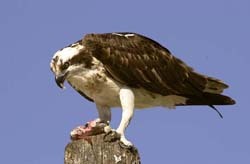
Fun Facts About Ospreys
- Unique among North American raptors for its diet of live fish and ability to dive into water to catch them, Ospreys are common sights soaring over shorelines, patrolling waterways, and standing on their huge stick nests, white heads gleaming. These large, rangy hawks do well around humans and have rebounded in numbers following the ban on the pesticide DDT.
- Hunting Ospreys are a picture of concentration, diving with feet outstretched and yellow eyes sighting straight along their talons.
- The Osprey is the only hawk on the continent that eats almost exclusively live fish. In North America, more than 80 species of live fresh- and saltwater fish account for 99 percent of the Osprey’s diet. Captured fish usually measure about 6–13 inches in length and weigh one-third to two-thirds of a pound. The largest catch on record weighed about 2.5 pounds.
- Adept at soaring and diving but not as maneuverable as other hawks, Ospreys keep to open areas, flying with stiff wingbeats in a steady, rowing motion. Primarily solitary birds, they usually roost alone or in small winter flocks of six to ten. Nesting Ospreys defend only the immediate area around their nest rather than a larger territory; they vigorously chase other Ospreys that encroach on their nesting areas. In breeding season, males perform an aerial "sky-dance," sometimes called "fish-flight." With dangling legs, often clasping a fish or nesting material in his talons, the male alternates periods of hovering with slow, shallow swoops as high as 600 feet or more above the nest site. Sustaining this display for 10 minutes or more, he utters repeated screaming calls while gradually descending in an undulating fashion to the nest.
- Ospreys require nest sites in open surroundings for easy approach, with a wide, sturdy base and safety from ground predators (such as raccoons). Nests are usually built on snags, treetops, or crotches between large branches and trunks; on cliffs or human-built platforms. Usually the male finds the site before the female arrives. Osprey nests are built of sticks and lined with bark, sod, grasses, vines, algae, or flotsam and jetsam. The male usually fetches most of the nesting material—sometimes breaking dead sticks off nearby trees as he flies past—and the female arranges it. Nests on artificial platforms, especially in a pair’s first season, are relatively small—less than 2.5 feet in diameter and 3–6 inches deep. After generations of adding to the nest year after year, Ospreys can end up with nests 10–13 feet deep and 3–6 feet in diameter—easily big enough for a human to sit in.
- The oldest known Osprey was at least 25 years, 2 months old, and lived in Virginia. It was banded in 1973, and found in 1998.

